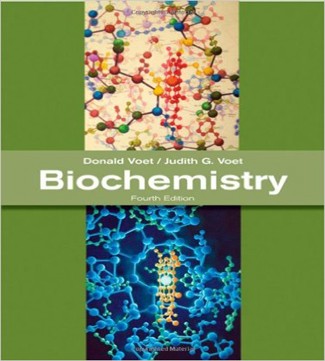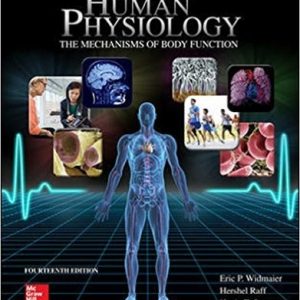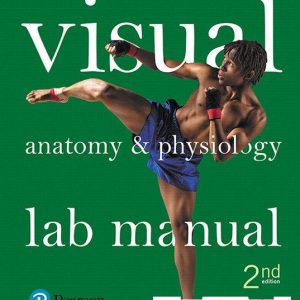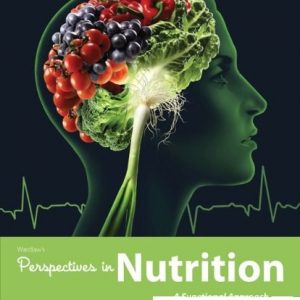This is completed downloadable of Biochemistry 4th Edition Voet Voet Test Bank

Product Details:
ISBN: 978-0470570951
Author;
The Gold Standard in Biochemistry text books. Biochemistry 4e, is a modern classic that has been thoroughly revised. Don and Judy Voet explain biochemical concepts while offering a unified presentation of life and its variation through evolution. Incorporates both classical and current research to illustrate the historical source of much of our biochemical knowledge.
Table of Content:
- PART I INTRODUCTION AND BACKGROUND
- CHAPTER 1 Life
- 1. Prokaryotes
- 2. Eukaryotes
- 3. Biochemistry: A Prologue
- 4. Genetics: A Review
- 5. The Origin of Life
- 6. The Biochemical Literature
- CHAPTER 2 Aqueous Solutions
- 1. Properties of Water
- 2. Acids, Bases, and Buffers
- CHAPTER 3 Thermodynamic Principles: A Review
- 1. First Law of Thermodynamics: Energy Is Conserved
- 2. Second Law of Thermodynamics: The Universe Tends Toward Maximum Disorder
- 3. Free Energy: The Indicator of Spontaneity
- 4. Chemical Equilibria
- APPENDIX: Concentration Dependence of Free Energy
- PART II BIOMOLECULES
- CHAPTER 4 Amino Acids
- 1. The Amino Acids of Proteins
- 2. Optical Activity
- 3. “Nonstandard” Amino Acids
- CHAPTER 5 Nucleic Acids, Gene Expression, and Recombinant DNA Technology
- 1. Nucleotides and Nucleic Acids
- 2. DNA Is the Carrier of Genetic Information
- 3. Double Helical DNA
- 4. Gene Expression and Replication: An Overview
- 5. Molecular Cloning
- CHAPTER 6 Techniques of Protein and Nucleic Acid Purifications
- 1. Protein Isolation
- 2. Solubilities of Proteins
- 3. Chromatographic Separations
- 4. Electrophoresis
- 5. Ultracentrifugation
- 6. Nucleic Acid Fractionation
- CHAPTER 7 Covalent Structures of Proteins and Nucleic Acids
- 1. Primary Structure Determination of Proteins
- 2. Nucleic Acid Sequencing
- 3. Chemical Evolution
- 4. Bioinformatics: An Introduction
- 5. Chemical Synthesis of Polypeptides
- 6. Chemical Synthesis of Oligonucleotides
- CHAPTER 8 Three-Dimensional Structures of Proteins
- 1. Secondary Structure
- 2. Fibrous Proteins
- 3. Globular Proteins
- 4. Protein Stability
- 5. Quaternary Structure
- APPENDIX: Viewing Stereo Pictures
- CHAPTER 9 Protein Folding, Dynamics, and Structural Evolution
- 1. Protein Folding: Theory and Experiment
- 2. Folding Accessory Proteins
- 3. Protein Structure Prediction and Design
- 4. Protein Dynamics
- 5. Conformational Diseases: Amyloids and Prions
- 6. Structural Evolution
- CHAPTER 10 Hemoglobin: Protein Function in Microcosm
- 1. Hemoglobin and Myoglobin Function
- 2. Structure and Mechanism
- 3. Abnormal Hemoglobins
- 4. Allosteric Regulation
- APPENDIX: Derivation of Symmetry Model Equations
- CHAPTER 11 Sugars and Polysaccharides
- 1. Monosaccharides
- 2. Polysaccharides
- 3. Glycoproteins
- CHAPTER 12 Lipids and Membranes
- 1. Lipid Classification
- 2. Properties of Lipid Aggregates
- 3. Biological Membranes
- 4. Membrane Assembly and Protein Targeting
- 5. Lipoproteins
- PART III MECHANISMS OF ENZYME ACTION
- CHAPTER 13 Introduction to Enzymes
- 1. Historical Perspective
- 2. Substrate Specificity
- 3. Coenzymes
- 4. Regulation of Enzymatic Activity
- 5. A Primer of Enzyme Nomenclature
- CHAPTER 14 Rates of Enzymatic Reactions
- 1. Chemical Kinetics
- 2. Enzyme Kinetics
- 3. Inhibition
- 4. Effects of pH
- 5. Bisubstrate Reactions
- APPENDIX: Derivations of Michaelis–Menten Equation Variants
- CHAPTER 15 Enzymatic Catalysis
- 1. Catalytic Mechanisms
- 2. Lysozyme
- 3. Serine Proteases
- 4. Drug Design
- PART IV METABOLISM
- CHAPTER 16 Introduction to Metabolism
- 1. Metabolic Pathways
- 2. Organic Reaction Mechanisms
- 3. Experimental Approaches to the Study of Metabolism
- 4. Thermodynamics of Phosphate Compounds
- 5. Oxidation–Reduction Reactions
- 6. Thermodynamics of Life
- CHAPTER 17 Glycolysis
- 1. The Glycolytic Pathway
- 2. The Reactions of Glycolysis
- 3. Fermentation: The Anaerobic Fate of Pyruvate
- 4. Metabolic Regulation and Control
- 5. Metabolism of Hexoses Other than Glucose
- CHAPTER 18 Glycogen Metabolism
- 1. Glycogen Breakdown
- 2. Glycogen Synthesis
- 3. Control of Glycogen Metabolism
- 4. Glycogen Storage Diseases
- CHAPTER 19 Signal Transduction
- 1. Hormones
- 2. Heterotrimeric G Proteins
- 3. Tyrosine Kinase–Based Signaling
- 4. The Phosphoinositide Cascade
- CHAPTER 20 Transport through Membranes
- 1. Thermodynamics of Transport
- 2. Kinetics and Mechanisms of Transport
- 3. ATP-Driven Active Transport
- 4. Ion Gradient–Driven Active Transport
- 5. Neurotransmission
- CHAPTER 21 Citric Acid Cycle
- 1. Cycle Overview
- 2. Metabolic Sources of Acetyl-Coenzyme A
- 3. Enzymes of the Citric Acid Cycle
- 4. Regulation of the Citric Acid Cycle
- 5. The Amphibolic Nature of the Citric Acid Cycle
- CHAPTER 22 Electron Transport and Oxidative Phosphorylation
- 1. The Mitochondrion
- 2. Electron Transport
- 3. Oxidative Phosphorylation
- 4. Control of ATP Production
- CHAPTER 23 Other Pathways of Carbohydrate Metabolism
- 1. Gluconeogenesis
- 2. The Glyoxylate Cycle
- 3. Biosynthesis of Oligosaccharides and Glycoproteins
- 4. The Pentose Phosphate Pathway
- CHAPTER 24 Photosynthesis
- 1. Chloroplasts
- 2. Light Reactions
- 3. Dark Reactions
- CHAPTER 25 Lipid Metabolism
- 1. Lipid Digestion, Absorption, and Transport
- 2. Fatty Acid Oxidation
- 3. Ketone Bodies
- 4. Fatty Acid Biosynthesis
- 5. Regulation of Fatty Acid Metabolism
- 6. Cholesterol Metabolism
- 7. Eicosanoid Metabolism: Prostaglandins, Prostacyclins, Thromboxanes, Leukotrienes, and Lipoxins
- 8. Phospholipid and Glycolipid Metabolism
- CHAPTER 26 Amino Acid Metabolism
- 1. Amino Acid Deamination
- 2. The Urea Cycle
- 3. Metabolic Breakdown of Individual Amino Acids
- 4. Amino Acids as Biosynthetic Precursors
- 5. Amino Acid Biosynthesis
- 6. Nitrogen Fixation
- CHAPTER 27 Energy Metabolism: Integration and Organ Specialization
- 1. Major Pathways and Strategies of Energy Metabolism: A Summary
- 2. Organ Specialization
- 3. Metabolic Homeostasis: Regulation of Appetite, Energy Expenditure, and Body Weight
- 4. Metabolic Adaptation
- CHAPTER 28 Nucleotide Metabolism
- 1. Synthesis of Purine Ribonucleotides
- 2. Synthesis of Pyrimidine Ribonucleotides
- 3. Formation of Deoxyribonucleotides
- 4. Nucleotide Degradation
- 5. Biosynthesis of Nucleotide Coenzymes
- PART V EXPRESSION AND TRANSMISSION OF GENETIC INFORMATION
- CHAPTER 29 Nucleic Acid Structures
- 1. Double Helical Structures
- 2. Forces Stabilizing Nucleic Acid Structures
- 3. Supercoiled DNA
- CHAPTER 30 DNA Replication, Repair, and Recombination
- 1. DNA Replication: An Overview
- 2. Enzymes of Replication
- 3. Prokaryotic Replication
- 4. Eukaryotic Replication
- 5. Repair of DNA
- 6. Recombination and Mobile Genetic Elements
- 7. DNA Methylation and Trinucleotide Repeat Expansions
- CHAPTER 31 Transcription
- 1. The Role of RNA in Protein Synthesis
- 2. RNA Polymerase
- 3. Control of Transcription in Prokaryotes
- 4. Post-Transcriptional Processing
- CHAPTER 32 Translation
- 1. The Genetic Code
- 2. Transfer RNA and Its Aminoacylation
- 3. Ribosomes
- 4. Control of Eukaryotic Translation
- 5. Post-Translational Modification
- 6. Protein Degradation
- INDEX
- WEB INDEX





